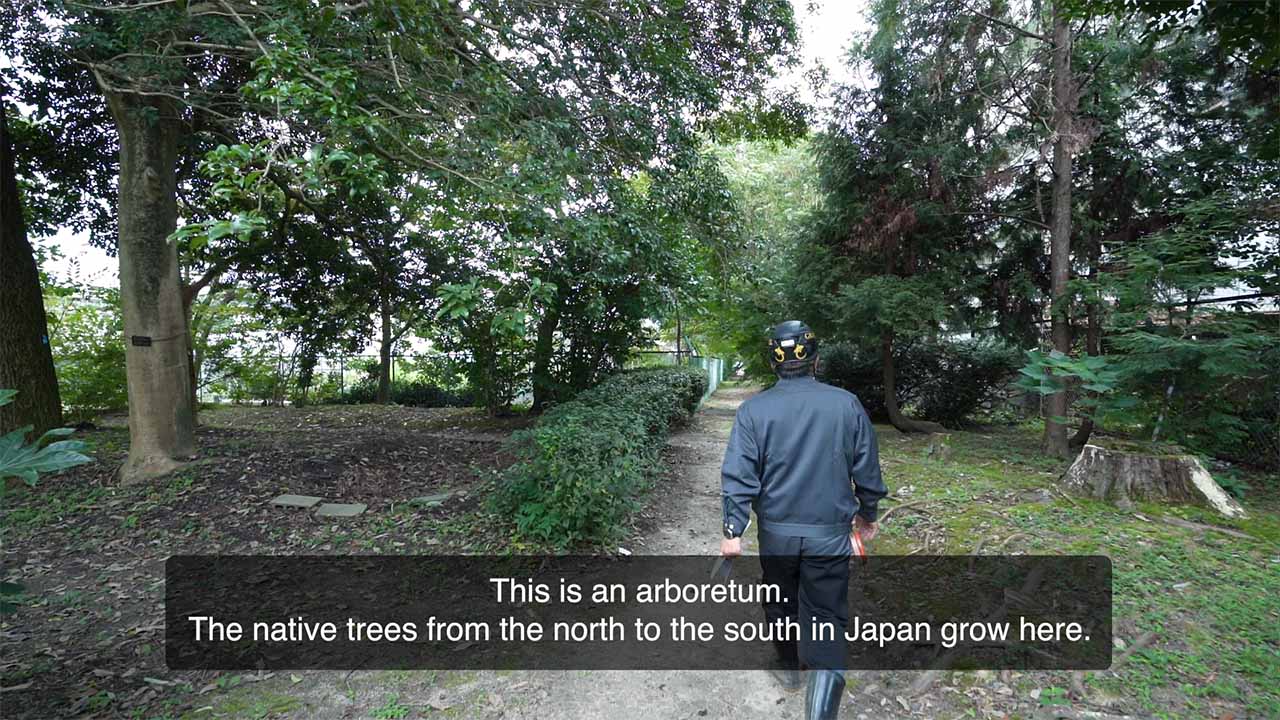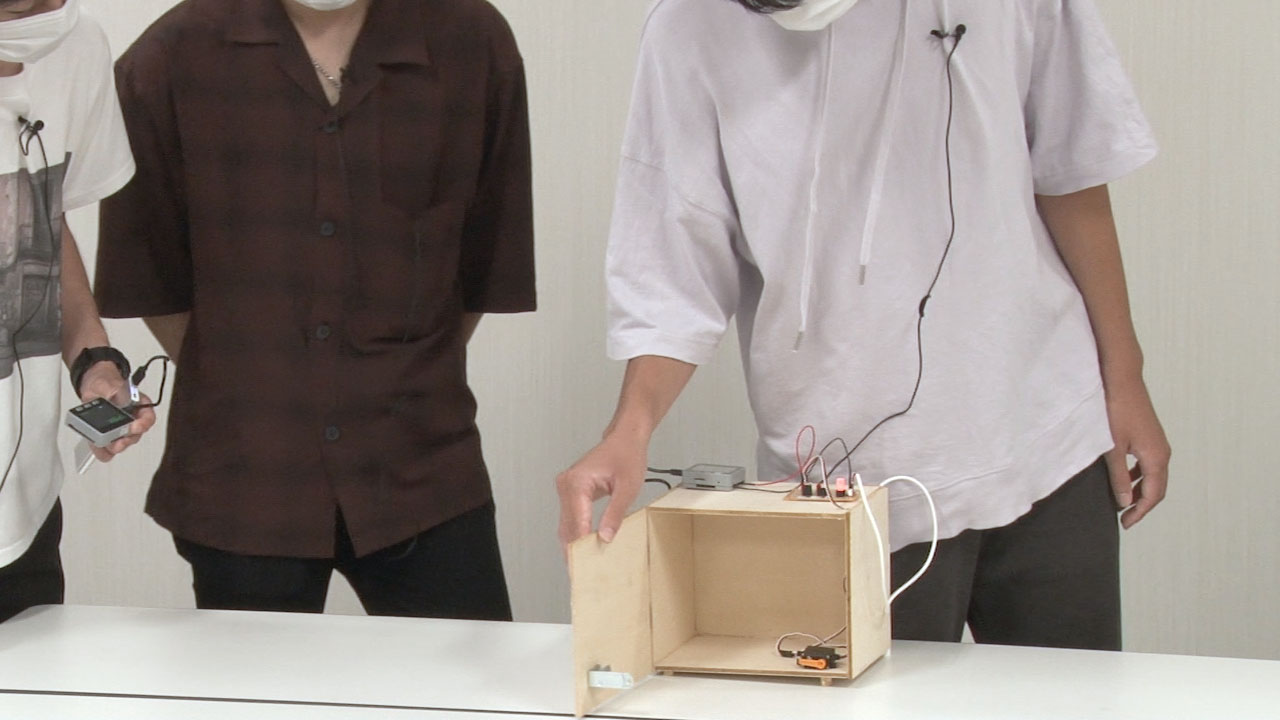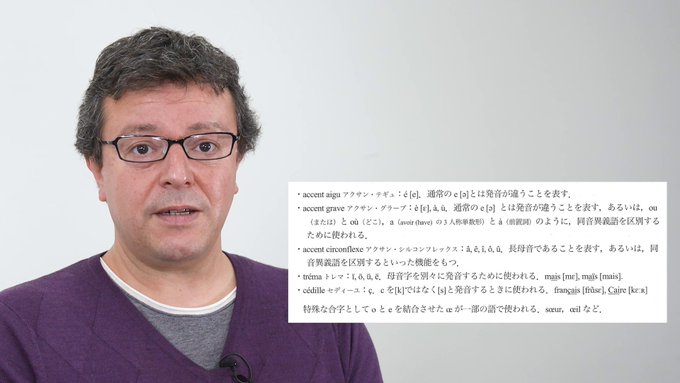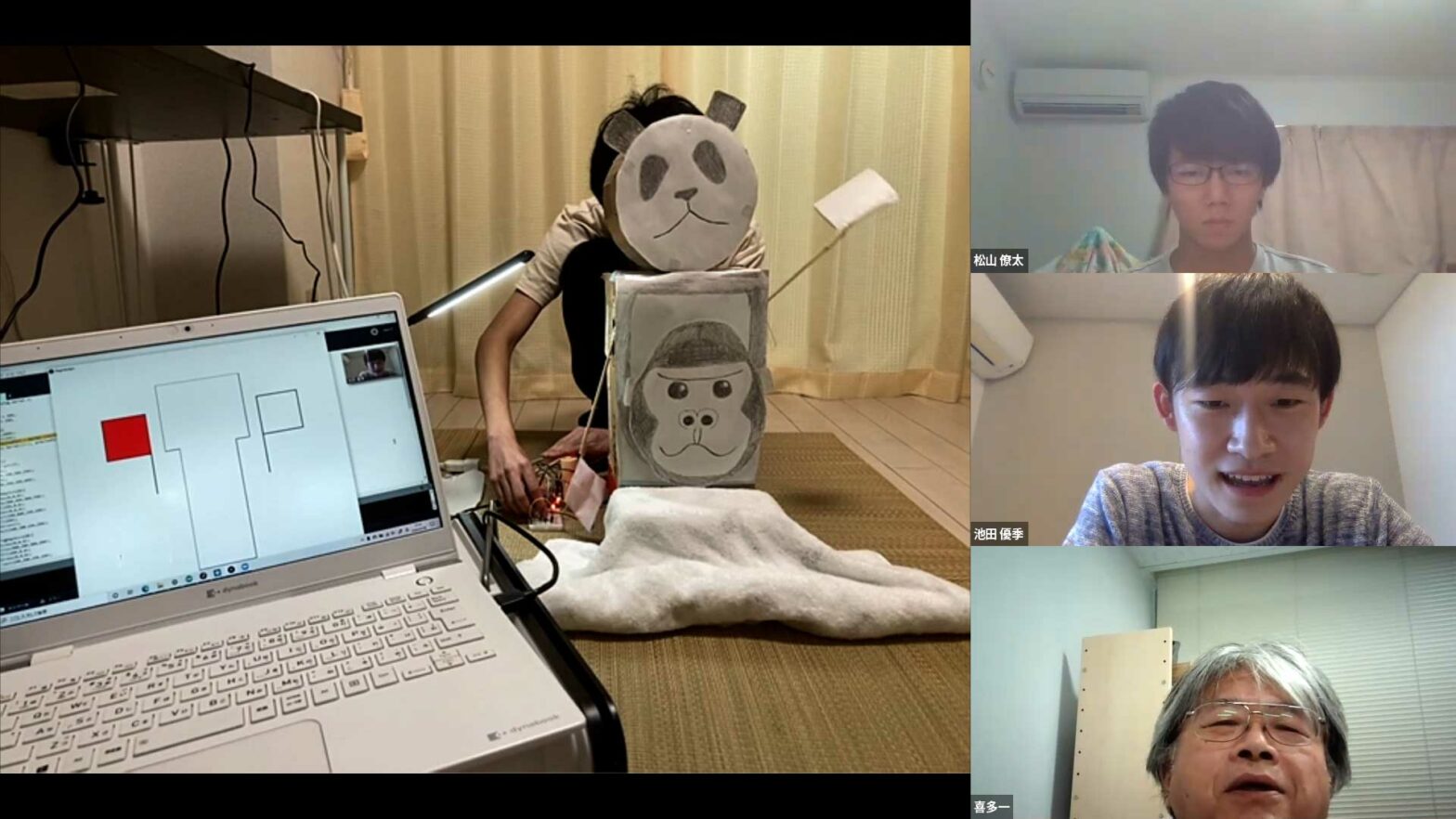工学系アートのススメ
2011年度学生作品ショートムービー「(仮)鉛筆」 -
授業の概要目的
このゼミでは、感情、意識、ノンバーバルな情報を扱ったコミュニケーションを テーマにアート&テクノロジー領域を研究、作品制作を行います。さらに、未来のコンピュータの不可欠なコミュニケーション能力である定量化できなかった個人の感情・意識・民族性・物語性といった人々に内属する文化の本質を表現し、文化の精神に触れるインターフェースを研究します。文化には、固有のまたは共通の形式があります。人間が歴史の中で行為や文法などの形で蓄えてきたものをモデル化し、ITを用いてインタラクティブな表現、文化理解体験をする方法を、「カルチュラル・コンピューティング」と定義します。 特に日本文化のコンピューティングに注目し、ほとんどコンピューティングの対象となって来なかった 1.日本の移ろいやすい気象・自然風土「もののあわれ」などの無常思想、「わび、さび」などの美意識 2.日本文化とアジア文化との関係性 3.神仏習合を根底とした文化構造 4.和歌、俳譜や能などの日本語独特の特性 5.日本的意匠(紋、織、色、型、能、歌舞伎)を研究します。
-

- 2009年度学生作品ショートムービー「となりの坂本さん 番外編 ~雨もしたたるいい男~」
-
-
2012/04/12 03:51 日本語
-

- NEURO BABY “MIC”2000
-
土佐 尚子(情報環境機構)
2012/04/13 06:50 日本語
-

- Neuro Baby Internet Mail
-
土佐 尚子(情報環境機構)
2012/04/13 04:13 英語
-

- Interactive Poem
-
土佐 尚子(情報環境機構)
2012/04/13 03:54 英語
-

- Interactive Computer Theater ~Romeo & Juliet in Hades~
-
土佐 尚子(情報環境機構)
2012/04/13 06:45 英語
-

- Unconscious Flow
-
土佐 尚子(情報環境機構)
2012/04/13 06:10 英語
-

- Interactive MANZAI
-
土佐 尚子(情報環境機構)
2012/04/13 06:00 英語
-

- Cultural Computing ~ZENetic Computer~
-
土佐 尚子(情報環境機構)
2012/04/13 15:45 英語
-

- i.Plot
-
土佐 尚子(情報環境機構)
2012/04/13 06:15 英語
-

- Hitch-Haiku
-
土佐 尚子(情報環境機構)
2012/04/13 05:59 英語
-

- 2011年度学生作品ショートムービー「」高宮
-
-
2012/04/13 02:19 日本語
-

- 2011年度学生作品ショートムービー「橋」西嶋
-
-
2012/04/13 02:53 日本語
-

- 2011年度学生作品ショートムービー「根も葉もないウワサ」山形
-
-
2012/04/13 02:47 日本語
-

- 2011年度学生作品ショートムービー「MYSTERIOUS MIRROR」井藤
-
-
2012/04/13 03:03 日本語
-

- 2011年度学生作品ショートムービー「(仮)鉛筆」
-
-
2012/04/13 02:27 日本語
-

- 2010年度学生作品 連句映像
-
-
2012/04/13 17:13 日本語
-

- 2009年度学生作品ショートムービー「衝動」
-
-
2012/04/13 03:08 日本語
-

- 2007年度学生作品ショートムービー「silent sounds」北野貴章
-
-
2007/07/25 14:53 日本語
-
- 2012年度レポート 「Art and Technology Report」Mai Cong Hung
-
- 2012年度レポート 「工学系アートのススメ まとめレポート」瀬川 智子
-
- 2012年度レポート 「工学系アートのススメ最終レポート」川本 稜
-
- 2010年度学生作品 俳句とかさね HitchHaiku + Kasane 春分 / 桜萌黄の襲(青木 舞)
-
- 2010年度学生作品 俳句とかさね HitchHaiku + Kasane 春分 / 桜萌黄の襲(尾崎 達哉)
-
- 2010年度学生作品 俳句とかさね HitchHaiku + Kasane 小満 / 卯の花の襲(鷲尾 尚也)
-
- 2010年度学生作品 俳句とかさね HitchHaiku + Kasane 夏至 / 蓬の襲(前田 和輝)
-
- 2010年度学生作品 俳句とかさね HitchHaiku + Kasane 大暑 / 二藍の襲(前澤 俊哉)
-
- 2010年度学生作品 俳句とかさね HitchHaiku + Kasane 霜降 / 紅葉の襲(日下 千夏)
-
- 2010年度学生作品 俳句とかさね HitchHaiku + Kasane 冬至 / 檜皮の襲(柴田 悠)
-
- 2010年度学生作品 俳句とかさね HitchHaiku + Kasane 冬至 / 檜皮の襲(豊島 絹世)
-
- 2010年度学生作品 俳句とかさね HitchHaiku + Kasane 大寒 / 松の襲(熊切 俊祐)
-
- 2009年度学生作品 映像「甲骨走馬燈歌仙」
-
- 2009年度学生作品 都々逸(どどいつ)塩野渚
-
- 2009年度学生作品 都々逸(どどいつ)池宮由楽
-
- 2009年度学生作品 都々逸(どどいつ)植松広一郎
-
- 2009年度学生作品 メディアアート研究座「連句三十六歌仙」
講義詳細
- 年度・期
- 2012年度・前期
- 開講部局名
- 全学共通科目
- 使用言語
- 日本語
- 教員/講師名
- 土佐 尚子(情報環境機構)
シラバス
| 開講年度・開講期 | 2012年度 前期 | 授業形態 | ゼミナール |
|---|---|---|---|
| 対象学生 | 1回生 | 曜時限 | 火5 |
| 教員 | 土佐 尚子(情報環境機構) |
||
| 授業の概要・目的 | このゼミでは、感情、意識、ノンバーバルな情報を扱ったコミュニケーションを テーマにアート&テクノロジー領域を研究、作品制作を行います。さらに、未来のコンピュータの不可欠なコミュニケーション能力である定量化できなかった個人の感情・意識・民族性・物語性といった人々に内属する文化の本質を表現し、文化の精神に触れるインターフェースを研究します。文化には、固有のまたは共通の形式があります。人間が歴史の中で行為や文法などの形で蓄えてきたものをモデル化し、ITを用いてインタラクティブな表現、文化理解体験をする方法を、「カルチュラル・コンピューティング」と定義します。 特に日本文化のコンピューティングに注目し、ほとんどコンピューティングの対象となって来なかった 1.日本の移ろいやすい気象・自然風土「もののあわれ」などの無常思想、「わび、さび」などの美意識 2.日本文化とアジア文化との関係性 3.神仏習合を根底とした文化構造 4.和歌、俳譜や能などの日本語独特の特性 5.日本的意匠(紋、織、色、型、能、歌舞伎)を研究します。 土佐教授 作品 NEURO BABY "MIC"2000 Why do people, regardless of age or gender, have an affinity for objects manifested in the human form? From the earthen figures of ancient times to mechanical dolls, teddy bears and robots, is it not true that man has conceived such objects in his imagination, then formed attachments and transferred emotions to them? In this paper, we address the issues of communication and esthetics of artificial life that possess this "human form" in modern society, both from artistic and engineering standpoints. An example is presented in which emotions are interpreted from human voices and emotional responses are triggered within the interactive setting of "MIC & MUSE." NEURO BABY Internet When exchanging email, since we often use few words, it often happens that exact sentiments are lost in the translation, leading to misunderstanding. It's characteristic of email communication that one message can be sent and misunderstood, resulting in awkwardness that may be difficult to recover from. This software has been designed to convey sentiments between parties more reliably Interactive Poem "Interactive poem" is a new type of poem that is created by a participant and a computer agent collaborating in a poetic world full of inspiration, emotion and sensitivity. The concept of this interactive poem is based on conventional poetry, but goes beyond traditional limits by introducing the capability of interaction. A participant and a computer agent create a dialogue by exchanging short poetic phrases, and through this exchange produce a new poetic world that integrates the poetic world of the agent with his/her own. A computer agent called "MUSE", who has been carefully designed with a face suitable for expressing the emotions of a poetic world, appears on the screen. She will utter a short poetic phrase to the participant. Hearing it allows him/her to enter the world of the poem and, at the same time, feel an impulse to respond by uttering one of the optional phrases or by creating his/her own poetic phrase. Exchanging poetic phrases through this interactive process allows the participant and MUSE to become collaborative poets who generate a new poem and a new poetic world. Interactive Computer Theater ~Romeo & Juliet in Hades~ Interactive movies, in which interaction capabilities are introduced into movies, is considered to be a new type of media that integrates various media, including telecommunications, movies, and video games. In interactive movies, people enter cyberspace and enjoy the development of a story there by interacting with the characters in the story. In this paper, we first explain the concept of interactive movies using examples of movies developed on a prototype system, then describe techniques for improving the interactivity. The current system incorporates two significant improvements for multimedia interactivity: the introduction of interaction at any time and two-person participation through the use of network communications. The software and hardware configurations of the system are briefly summarized. The paper concludes with an example of an interactive story installed in this system and briefly describes the interaction between the participants and the system. Unconscious Flow In face-to-face communication, the occasional need for intentional lies is something with which everyone can identify. For example, when we get mad, circumstances may force us to put on a big smile instead of expressing our anger; when we feel miserable, good manners may dictate that we greet others warmly. In short, to abide by social norms, we consciously lie. On the other hand, if we consider the signs that our bodies express as com munication (body language), we can say that the body does not lie even while the mind does. Considering this phe nomenon, we propose "touching the heart" in a somewhat Japan ese way by measuring the heartbeat of the "honest" body and using other technolo gies to reveal a new code of non-verbal communication from a hidden dimension in society. We call this "tech no-healing art." Two computer-generated mermaids function as individ ual agents for two viewers. Each mermaid agent moves in sync with the heart rate detected by an electrode attached to the collarbone of its viewer. Then, using a synchronization interaction model that calculates the mutual heart rate on a personal computer, the two mer maids express hidden non-verbal communication.The data of relax-strain calculated from the heart rate and the interest calculated from the variation in the heart rate are mapped on the mode.The synchronization interaction model reveals the communication codes in the hidden dimension that do not appear in our superfi cial communication.Then, using a camera to pick up hand gestures and a personal computer to analyze the images, the synchronization interaction model is applied to determine the mermaid's behavior. For a high degree of synchronisation, the agents mimic the hand gestures of their subjects, but for a low degree of syn chronisation, the agents run away. In the event that one mermaid agent touches the other, a pseudo-touch can be felt through the use of a vibration device. As for background sound, the heart sound of the subjects are picked up by an electronic stethoscope and processed for output on a personal computer. Interactive MANZAI Generally, technology looks at the external value of an object. At a very deep level, however, laughter comes from the touch of living—decidedly an internal value. It is very difficult to fully comprehend this deep relationship. Our personal feeling is the key to grasping the phenomenon of laughter, which is not an issue of analysis or understanding but one of the mind’s spontaneity, such as the emergence of an idea or a burst of imagination. Laughter is an intelligence that emerges through sympathetic communications and, therefore, has great power. Recently, artificial intelligence research has focused too much on analysis and knowledge and, consequently, risks being capable of achieving only boring results. Genuine intelligence is not boring, so the intelligence we develop should not be boring. To meet this challenge, I have developed a comedy system that enables humans and computers to interact and create laughter. Cultural Computing ~ZENetic Computer~ ZENetic is an interface that evokes self-awakening through essential aspects of Zen Buddhist culture. Through esoteric riddles, ZENetic teases particular cognitive responses from users, as reflections of their inner, subliminal consciousness. With stories portrayed in ink painting, haiku, and kimono, ZENetic conveys the rich allegorical interaction characteristic of Eastern philosophy. People of many different nationalities, cultures, and customs live in the world. With a new method of inter-cultural computing that uses advanced interaction technologies, we can offer a totally new and personal experience through which people can feel and understand different cultures. Based on this approach, everybody can gain cross-cultural understanding that leads to a real understanding of "symbiosis." This real understanding of different cultures is very important for peace throughout the world. From this beginning, we will extend our cross-cultural translation system on the network to encourage interchanges in cultural anthropology, art, literature, philosophy, psychology, and sociology. To develop new theories, models, and methods, that may shed new light on how a given culture may be translated into a format that would enable users from different cultural origins to access the deeper significance of the translated culture. ZENetic applies some aspects of Buddhist philosophy as a model in computational science. Our motivation derives from the more than 2,000 years of innovative Buddhist tradition. Methods of interaction between Zen master and pupil, developed to sharpen the understanding of human consciousness, provide a rich base for interactive modeling -- a field still unexplored in the Western scientific tradition. i.Plot In the history of art-and-science research, which began in the late 1960s, one aspect that has received insufficient attention is the field's relationship to literature (narrative), perhaps because technological factors discouraged literature specialists from approaching the field. But now that the use of computers as an inter-medium is finally beginning to mature, it has possible for men and women of letters to get closer to computers. This project uses "the future of narrative" as a theme to research how computers can offer humor, wisdom, and inspiration. So far, art-and-science research projects have focused mainly on nonverbal communication modes, such as feeling and atmosphere. In i.plot, the logical meaning of language and its intuitive aspects, such as atmosphere and feeling, have been joined together. The goal of this project is to make a future of narrative that can generate interactive literature and scripts for interactive cinema. Hitch-Haiku Hitch Haiku is a system based on cultural computing that interactively aids users in generating haiku, the world's shortest poems with imagery-maximizing mechanisms. First, "kire-ji" and particles are added to the word(s) input by a user to make a five or seven-character phrase, then phrases including terminology related to the user's input are located in a phrase database holding examples of haiku from the literary calendar, ensuring the cultural validity of the haiku. These phrases are then "hitched” together to generate a haiku. Although the haiku generated by this system have periodically resulted in flawed haiku, the ability to generate haiku that support the expansion of users' minds has been confirmed through assessment experimentation. |
||
| 授業計画と内容 | 以下のような課題について、授業で研究、実習をする予定である。 1)脳内イメージと映像 漢字の脳内イメージ 2)漢字の背景の豊穣な文化 漢字には原初の祈念や欲望がある 漢字の世界観 文字本来の「力」 3)呪能をもつ漢字 甲骨文の誕生 甲骨文は神聖な王のためのもの 「 サイ」とは言霊の入れもの サイから広がる漢字群 4)イメージと言語をつなぐ甲骨文字 漢字の成り立ちを現わす字源 古代は神話とともにはじまる 漢字の表意性と論理性 |
||
| 成績評価の方法・観点 | 作品課題、出席数、レポート 試験はしない |
||
| 履修要件 | アートや映像に興味があること、コンピュータを使って作品を作成することに関心があること、emailを送受信できる環境を持ち、自分のコンピュータを持っていること |
||
| 教科書・参考書等 | |||





